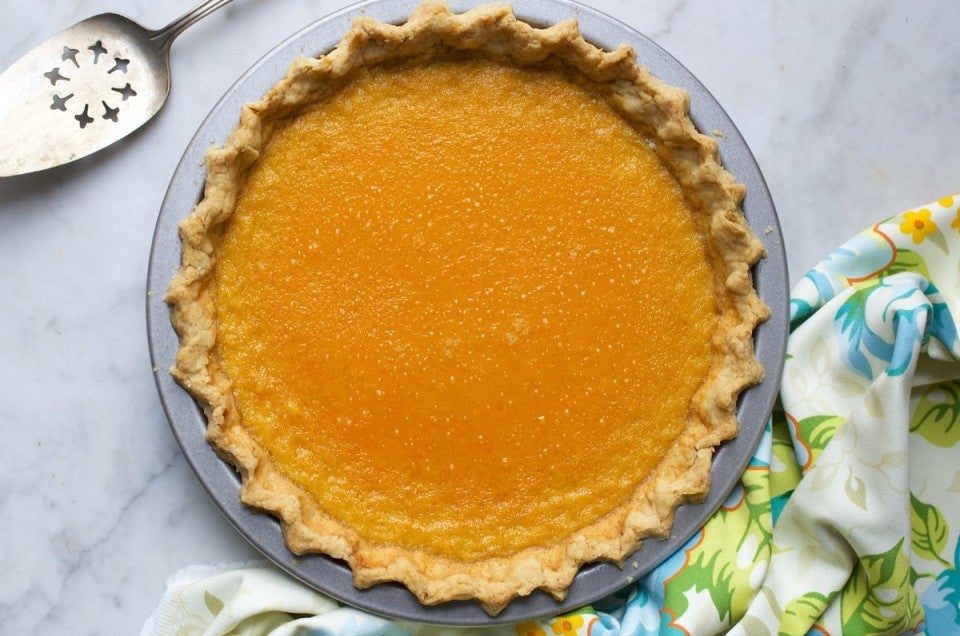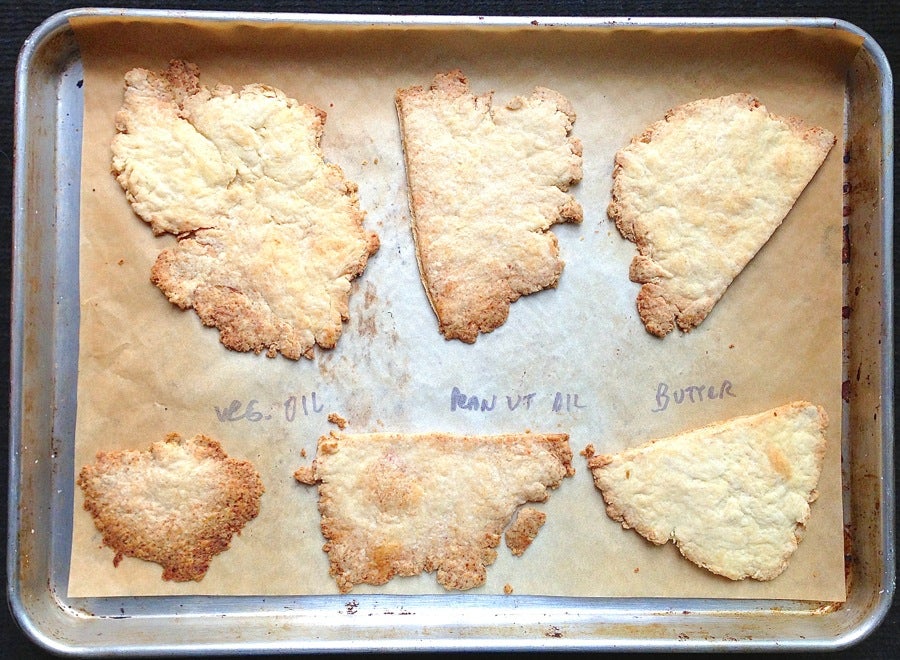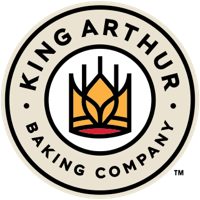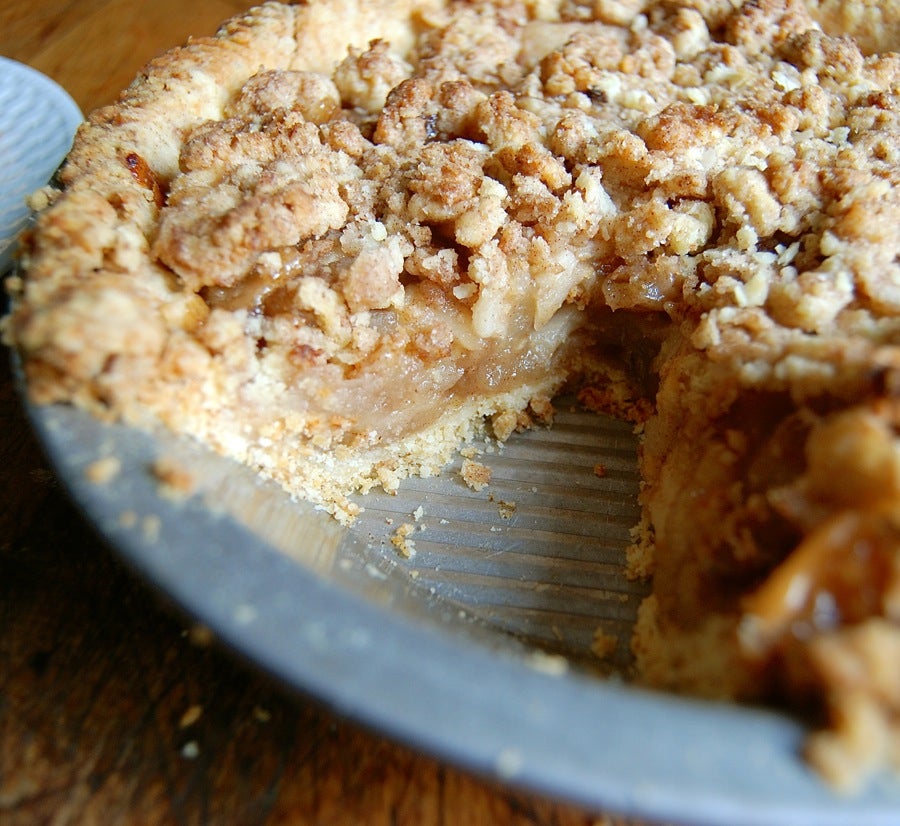


Do you suffer from crust-o-phobia?
Not the crackly-crisp crust of a baguette. Nor the shiny, whisper-thin crust atop a pan of brownies.
You know what crust I'm talking about: pie crust.
And when you think about it, it's not so much the pie crust itself you fear. I mean, what's so hard about combining flour and salt and butter and water?
No, it's the rolling-out part that gets to you – right?
Dough sticking to the pin. And to the counter. A rolled-out "circle" that resembles Australia. Or maybe South America.
Oh, and just try to pick that delicate crust up and lay it into its waiting pan... it cracks in the middle, the edges fall off, and you end up furiously flinging the whole thing into the trash.
Been there? Done that? If this scenario sounds familiar, I'm about to make your Thanksgiving pie-baking a whole lot easier.
Pie crust-challenged reader – meet No-Roll Pie Crust.
I call this crust the easy-as-pie crust. Use a fork to stir a few simple ingredients together in a bowl, then dump the clumpy mass into your pan. From then on, it's just like Play-Doh; simply press and mold the dough onto the bottom and up the sides of your pan. Remember to give it a nice crimp around the edge.
Add your favorite filling, and bake.
Trust me, it's as simple as that. And, bonus: this crisp, tasty crust is vegan, and contains neither trans fats nor cholesterol – for those following a special diet.
Ready to have your pie crust-baking life transformed? Read on.
Now, you have your choice of making a single or double pie crust here; I'm going to give you the ingredients for a double crust, but when you check out the recipe you'll see the single-ingredient amounts, as well.
Whisk together the following:
3 cups (12 3/4 ounces) King Arthur Unbleached All-Purpose Flour
1 teaspoon salt
1 1/2 teaspoons sugar
1/2 teaspoon baking powder
In a separate bowl, whisk together the following:
2/3 cup oil: canola, vegetable, olive, peanut, your choice; or melted butter
6 tablespoons cold water
Pour the oil mixture over the dry ingredients, and stir with a spatula or fork until the dough is evenly moistened.
Dump 2/3 of the dough into a 9" pie pan, reserving 1/3 for the top crust. If you have a scale, this is easy; if you don't, just eyeball it.
Pat the dough across the bottom of the pie pan and up the sides. A flat-bottomed measuring cup or glass helps smooth it out.
Crimp the edges of the crust, or flatten with the tines of a fork.
You can choose to roll out the remaining dough to make a conventional top crust, if you like; yes, the dough is perfectly roll-able, for those comfortable with a pin.
But if you want to leave your rolling pin in the cupboard, simply crumble the remaining dough over the filling in the pan. Since I'm making an apple pie, I've added 1 teaspoon ground cinnamon and 2 tablespoons sugar to the topping dough, for extra flavor.
Add your filling. Then either roll the remaining dough and lay it on top; or crumble it as is over the filling, like I've done here.
Place the pie on a parchment-lined baking sheet, to catch any potential spills.
Bake.
Pie-fection!
How about that crust? Looks good, eh?
I decided to do a small experiment, to see the difference in taste between plain vegetable oil and peanut oil, which I use for deep-frying. Then, for the heck of it, I added melted butter as an option, as well.

I preferred the flavor of the peanut oil crust to the one made with plain vegetable oil. But truth be told, the butter crust was the tastiest of all. Go with butter, if you like it and you're not avoiding dairy/cholesterol.
How about canola oil? Or olive oil? I haven't tried canola (just don't like it), but mild olive oil makes a lovely crust, with only a hint of olive oil flavor.
But wait, there's more –

Even without the typical layers of solid fat/liquid that create steam, which in turn generates flakiness – these crusts actually exhibit a bit of flake, aside from being tender and yummy.

Tender and tasty AND flaky, I give you no-roll apple pie.
Crust-o-phobia, begone!
Please read, rate, and review our recipe for No-Roll Pie Crust.









November 27, 2024 at 11:26am
Can this crust be made one day ahead and left out without refrigerating?
December 13, 2024 at 1:24pm
In reply to Can this crust be made one… by Sarah (not verified)
Hi Sarah, yes, you could blind bake this type of pie crust, allow it to cool, and then store it (wrapped in plastic) to prevent it drying out overnight.
October 4, 2024 at 10:23pm
Would it be possible to make hand pies with this crust? Maybe roll it out between wax paper, add filling, fold over and crimp?
October 8, 2024 at 11:55am
In reply to Would it be possible to make… by RC (not verified)
You certainly could, RC. No adjustments needed. Happy baking!
May 23, 2022 at 9:19pm
Can you make the pie ahead and freeze with this pie crust either pre baking or after baking?
May 25, 2022 at 7:40pm
In reply to Can you make the pie ahead… by Dena (not verified)
You certainly can, Dena! I would recommend freezing it before baking. Then, thaw in the fridge overnight prior to baking. Happy baking!
September 26, 2021 at 3:19pm
Crust problems solved for life! So much easier than cutting, chilling, rolling. I made with melted butter for an apple pie. I would say this crust is a tad less flakey and dryer than a traditional crust, but avoids the mistakes I so often have that lead to a soggy pie.
November 29, 2020 at 9:36pm
Crust-o-phobe here. I discovered no roll crusts a few years ago and decided to give this one a try. Hands down my new favorite. Flaky, tasty and stands up to the filling. It may even encourage me to make pie more often!
November 26, 2020 at 4:10pm
I tried making this using melted butter as suggested, but when I tried whisking the melted butter with the cokd water, the butter solidified and clumped up! I wound up microwaving it for 10 seconds to melt the butter and then let it cool before pouring it into the flour mixture. But that kind of defeated the purpose of using cold water. What do you recommend as a better way of doing this?
November 30, 2020 at 1:49pm
In reply to I tried making this using… by Jennifer (not verified)
We're sorry to hear about this experience, Jennifer! We might suggest melting the butter and letting it cool slightly before mixing it with the water. For this method, it's OK to use slightly warmer water to prevent the butter from solidifying. We hope this helps for future baking adventures!
Pagination